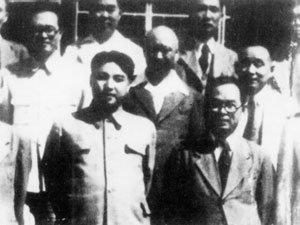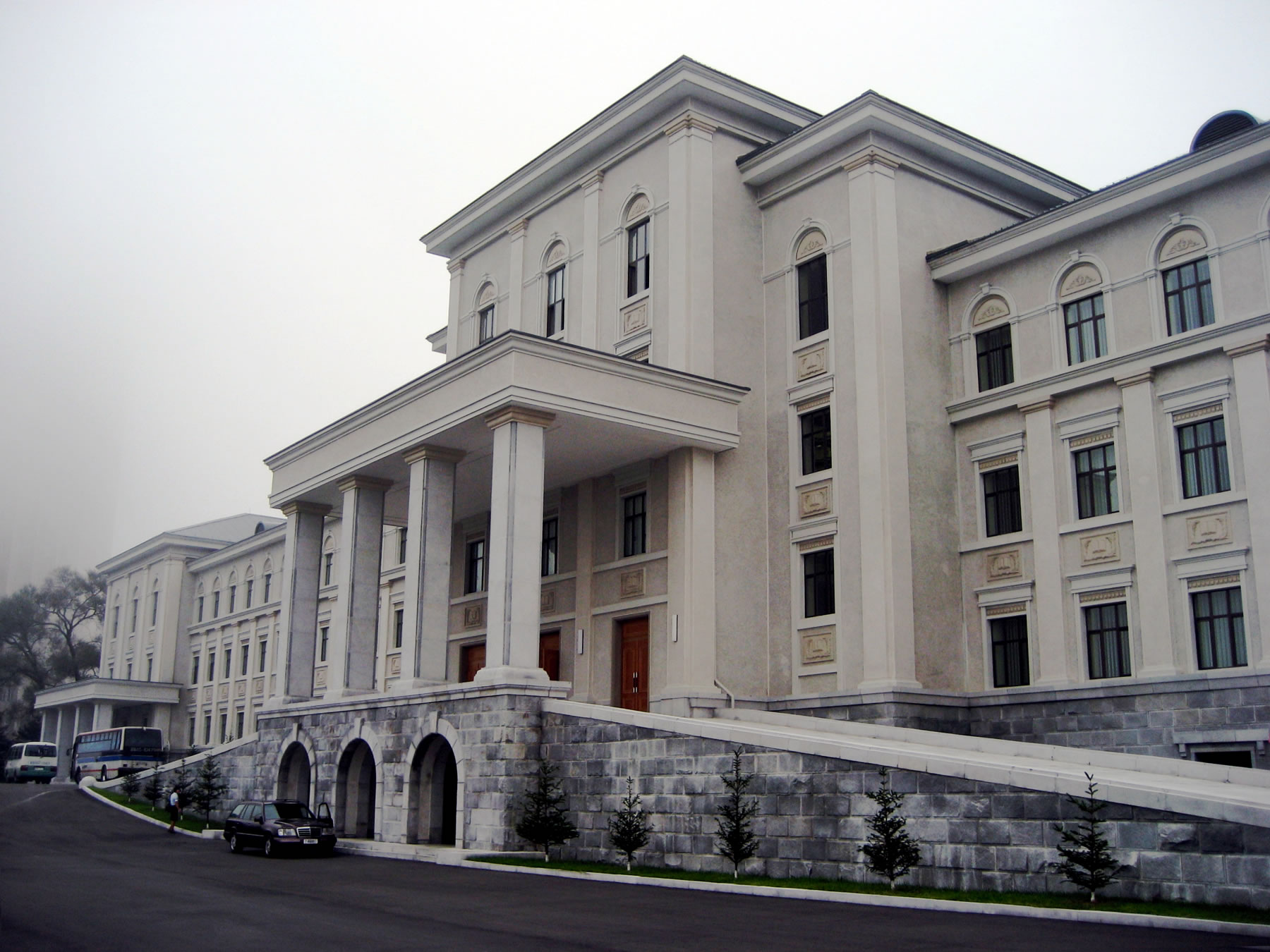|
Kim Il-sung Higher Party School
Kim Il Sung Higher Party School (김일성고급당학교) – a key party-political educational institution in the DPRK responsible for training and preparing the managerial staff of the Workers' Party of Korea and the state apparatus that is part of the Central Committee of the Workers' Party of Korea The Central Committee of the Workers' Party of Korea ( ko, 조선로동당 중앙위원회) is the highest party body between national meetings of the Workers' Party of Korea (WPK), the ruling party of North Korea. According to WPK rules, the .... It was founded on June 1, 1946, as the Central Party School of the Communist Party of North Korea based in Pyongyang, on the basis of the existing since November 1945 Kim Il Sung High School, who prepares political and educational officers and translators of the Russian language. On the sixtieth birthday of Kim Il-sun, in April 1972, his name was given to the university - the Kim Il Sung Higher Party School. A year later, in 1973, ... [...More Info...] [...Related Items...] OR: [Wikipedia] [Google] [Baidu] |
Tongdaewon-guyok
Tongdaewŏn-guyŏk or Tongdaewon District is one of the 18 wards, and one of the six that constitute East Pyongyang, North Korea. It sits on the eastern bank of the Taedong River The Taedong River (Chosŏn'gŭl: ) is a large river in North Korea. The river rises in the Rangrim Mountains of the country's north where it then flows southwest into Korea Bay at Namp'o.Suh, Dae-Sook (1987) "North Korea in 1986: Strengthening .... It is north of Sŏn'gyo-guyŏk (Songyo District), south of Taedonggang-guyŏk (Taedonggang District) and west of Sadong-guyŏk (Sadong District) and Ryŏkp'o-guyŏk (Ryokpho District). It was established in October 1960. Administrative divisions Tongdaewŏn-guyŏk is divided into 18 ''tong'' (neighbourhoods): * Ryul-dong 률동(栗洞) * Taesin-dong 대신동(大新洞) * Munsin 1-dong 문신 1동 (文新 1洞) * Munsin 2-dong 문신 2동 (文新 2洞) * Tongdaewŏn 1-dong 동대원 1동 (東大院 1洞) * Tongdaewŏn 2-dong 동대원 2동 (東大院 ... [...More Info...] [...Related Items...] OR: [Wikipedia] [Google] [Baidu] |
Pyongyang
Pyongyang (, , ) is the capital and largest city of North Korea, where it is known as the "Capital of the Revolution". Pyongyang is located on the Taedong River about upstream from its mouth on the Yellow Sea. According to the 2008 population census, it has a population of 3,255,288. Pyongyang is a directly administered city () with equal status to North Korean provinces. Pyongyang is one of the oldest cities in Korea. It was the capital of two ancient Korean kingdoms, Gojoseon and Goguryeo, and served as the secondary capital of Goryeo. Much of the city was destroyed during the First Sino-Japanese War, but it was revived Korea under Japanese rule, under Japanese rule and became an industrial center. Following the establishment of North Korea in 1948, Pyongyang became its ''de facto'' capital. The city was again devastated during the Korean War, but was quickly rebuilt after the war with Soviet Union, Soviet assistance. Pyongyang is the political, industrial and transport ... [...More Info...] [...Related Items...] OR: [Wikipedia] [Google] [Baidu] |
North Korea
North Korea, officially the Democratic People's Republic of Korea (DPRK), is a country in East Asia. It constitutes the northern half of the Korea, Korean Peninsula and shares borders with China and Russia to the north, at the Yalu River, Yalu (Amnok) and Tumen River, Tumen rivers, and South Korea to the south at the Korean Demilitarized Zone. North Korea's border with South Korea is a disputed border as both countries claim the entirety of the Korean Peninsula. The country's western border is formed by the Yellow Sea, while its eastern border is defined by the Sea of Japan. North Korea, like South Korea, its southern counterpart, claims to be the legitimate government of the entire peninsula and List of islands of North Korea, adjacent islands. Pyongyang is the capital and largest city. In 1910, Korean Empire, Korea was Korea under Japanese rule, annexed by the Empire of Japan. In 1945, after the Surrender of Japan, Japanese surrender at the End of World War II in Asia, end ... [...More Info...] [...Related Items...] OR: [Wikipedia] [Google] [Baidu] |
DPRK
North Korea, officially the Democratic People's Republic of Korea (DPRK), is a country in East Asia. It constitutes the northern half of the Korean Peninsula and shares borders with China and Russia to the north, at the Yalu (Amnok) and Tumen rivers, and South Korea to the south at the Korean Demilitarized Zone. North Korea's border with South Korea is a disputed border as both countries claim the entirety of the Korean Peninsula. The country's western border is formed by the Yellow Sea, while its eastern border is defined by the Sea of Japan. North Korea, like its southern counterpart, claims to be the legitimate government of the entire peninsula and adjacent islands. Pyongyang is the capital and largest city. In 1910, Korea was annexed by the Empire of Japan. In 1945, after the Japanese surrender at the end of World War II, Korea was divided into two zones along the 38th parallel, with the north occupied by the Soviet Union and the south occupied by the United Stat ... [...More Info...] [...Related Items...] OR: [Wikipedia] [Google] [Baidu] |
Workers' Party Of Korea
The Workers' Party of Korea (WPK) is the founding and sole ruling party of the Democratic People's Republic of Korea, commonly known as North Korea. Founded in 1949 from the merger of the Workers' Party of North Korea and the Workers' Party of South Korea, the WPK is the oldest active party in Korea. It also controls the Korean People's Army, North Korea's armed forces. The WPK is the largest party represented in the Supreme People's Assembly and coexists with two other legal parties making up the Democratic Front for the Reunification of Korea. However, these minor parties are completely subservient to the WPK and must accept the WPK's "Vanguard party, leading role" as a condition of their existence. The WPK is banned in South Korea (Republic of Korea) under the National Security Act (South Korea), National Security Act and is sanctioned by the United Nations, the European Union, Australia, and the United States. Officially, the WPK is a communist party guided by Kimilsungism� ... [...More Info...] [...Related Items...] OR: [Wikipedia] [Google] [Baidu] |
Central Committee Of The Workers' Party Of Korea
The Central Committee of the Workers' Party of Korea ( ko, 조선로동당 중앙위원회) is the highest party body between national meetings of the Workers' Party of Korea (WPK), the ruling party of North Korea. According to WPK rules, the Central Committee is elected by the party congress and the party conference can be conferred the right to renew its membership composition. In practice, the Central Committee has the ability to dismiss and appoint new members without consulting with the wider party at its own plenary sessions. The 1st Central Committee was elected at the 1st WPK Congress in 1946. It was composed of 43 members. The numbers of Central Committee members have increased since then, with the 7th Congress in 2017 electing 235 members. Non-voting members, officially referred to as alternate members at the present, was introduced at the 2nd Congress. The Central Committee convenes at least once a year for a plenary session ("meeting"), and shall function as a ... [...More Info...] [...Related Items...] OR: [Wikipedia] [Google] [Baidu] |
Politics Of North Korea
The politics of North Korea (officially the Democratic People's Republic of Korea or DPRK) takes place within the framework of the official state philosophy, Kimilsungism-Kimjongilism. ''Juche'', which is a part of Kimilsungism-Kimjongilism, is the belief that only through self-reliance and a strong independent state, can true socialism be achieved.B. R. Myers: ''The Cleanest Race: How North Koreans See Themselves and Why It Matters.'' pp. 45–46. Paperback edition. (2011) North Korea's political system is built upon the principle of centralization. While the North Korean constitution formally guarantees protection of human rights, in practice there are severe limits on freedom of expression, and the government closely supervises the lives of North Korean citizens. The constitution defines North Korea as "a dictatorship of people's democracy" under the leadership of the Workers' Party of Korea (WPK), which is given legal supremacy over other political parties. WPK General ... [...More Info...] [...Related Items...] OR: [Wikipedia] [Google] [Baidu] |
Education In Pyongyang
Education is a purposeful activity directed at achieving certain aims, such as transmitting knowledge or fostering skills and character traits. These aims may include the development of understanding, rationality, kindness, and honesty. Various researchers emphasize the role of critical thinking in order to distinguish education from indoctrination. Some theorists require that education results in an improvement of the student while others prefer a value-neutral definition of the term. In a slightly different sense, education may also refer, not to the process, but to the product of this process: the mental states and dispositions possessed by educated people. Education originated as the transmission of cultural heritage from one generation to the next. Today, educational goals increasingly encompass new ideas such as the liberation of learners, skills needed for modern society, empathy, and complex vocational skills. Types of education are commonly divided into formal, ... [...More Info...] [...Related Items...] OR: [Wikipedia] [Google] [Baidu] |
Universities In North Korea
There are more than 300 colleges and universities in North Korea.Library of Congress country study see p. 7 for Education and Literacy () Universities and colleges in North Korea are classified into central class and local colleges. Also, they can be classified into social, special, and military colleges. Special colleges were established with the purpose to raise top executives. Students who have just graduated from high school cannot enter special colleges without any experience in industrial or cooperative farm careers. In North Korea, there are only two universities such as and |
1946 Establishments In North Korea
Events January * January 6 - The 1946 North Vietnamese parliamentary election, first general election ever in Vietnam is held. * January 7 – The Allies recognize the Austrian republic with its 1937 borders, and divide the country into four Allied-occupied Austria, occupation zones. * January 10 ** The first meeting of the United Nations is held, at Methodist Central Hall Westminster in London. ** ''Project Diana'' bounces radar waves off the Moon, measuring the exact distance between the Earth and the Moon, and proves that communication is possible between Earth and outer space, effectively opening the Space Age. * January 11 - Enver Hoxha declares the People's Republic of Albania, with himself as prime minister of Albania, prime minister. * January 16 – Charles de Gaulle resigns as head of the Provisional Government of the French Republic, French provisional government. * January 17 - The United Nations Security Council holds its first session, at Church House, Westmin ... [...More Info...] [...Related Items...] OR: [Wikipedia] [Google] [Baidu] |







